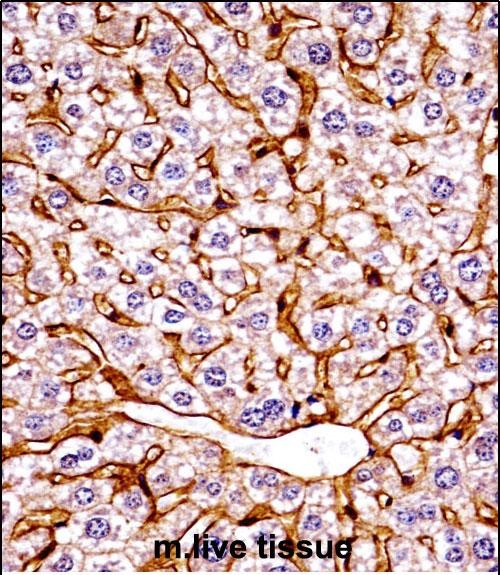

| WB | 1/1000 | Human,Mouse,Rat |
| IF | 咨询技术 | Human,Mouse,Rat |
| IHC | 1/100-1/500 | Human,Mouse,Rat |
| ICC | 技术咨询 | Human,Mouse,Rat |
| FCM | 咨询技术 | Human,Mouse,Rat |
| Elisa | 咨询技术 | Human,Mouse,Rat |
| Aliases | Eukaryotic translation initiation factor 2-alpha kinase 4, GCN2-like protein, mGCN2, Eif2ak4, Gcn2, Kiaa1338 |
| Entrez GeneID | 27103 |
| WB Predicted band size | 186.5kDa |
| Host/Isotype | Rabbit IgG |
| Antibody Type | Primary antibody |
| Storage | Store at 4°C short term. Aliquot and store at -20°C long term. Avoid freeze/thaw cycles. |
| Species Reactivity | Human, Mouse |
| Immunogen | This Mouse Eif2ak4 antibody is generated from rabbits immunized with a KLH conjugated synthetic peptide between 1477-1504 amino acids from the C-terminal region of mouse Eif2ak4. |
| Formulation | Purified antibody in PBS with 0.05% sodium azide. |
+ +
以下是关于小鼠Eif2ak4(GCN2)抗体的3篇参考文献,包含文献名称、作者及摘要概括:
---
1. **文献名称**:*The GCN2 kinase biases feeding behavior to maintain amino acid homeostasis in omnivores*
**作者**:Maurin, A.C. et al.
**摘要**:本研究利用Eif2ak4(GCN2)基因敲除小鼠模型,通过Western blot和免疫组化验证特异性抗体的有效性,证明GCN2通过感知氨基酸缺乏调控摄食行为,维持代谢稳态。抗体被用于检测小鼠肝脏及脑组织中GCN2蛋白的表达及磷酸化状态。
---
2. **文献名称**:*GCN2 sustains mTORC1 suppression upon amino acid deprivation by inducing Sestrin2*
**作者**:Ye, J. et al.
**摘要**:研究通过免疫沉淀(IP)和免疫荧光技术,使用小鼠Eif2ak4抗体,揭示了GCN2在氨基酸饥饿条件下通过Sestrin2调控mTORC1通路的分子机制。抗体特异性在小鼠胚胎成纤维细胞(MEFs)中经敲除模型验证。
---
3. **文献名称**:*Amino acid limitation regulates the expression of genes involved in several specific biological processes through GCN2-dependent and -independent pathways*
**作者**:Harding, H.P. et al.
**摘要**:经典研究利用Eif2ak4抗体(Western blot)证明GCN2激酶在氨基酸缺乏时磷酸化eIF2α,激活应激反应通路。实验在小鼠肝脏组织及细胞系中验证抗体特异性,并揭示GCN2在基因表达调控中的核心作用。
---
**备注**:以上文献年份较早(如Harding et al.为早期关键研究),若需最新研究建议补充关键词如“近年”、“CRISPR验证”进一步筛选。
The mouse Eif2ak4 antibody is designed to detect eukaryotic translation initiation factor 2 alpha kinase 4 (EIF2AK4), also known as general control nonderepressible 2 (GCN2), a critical enzyme in cellular stress response pathways. EIF2AK4/GCN2 is a serine/threonine kinase that senses amino acid deprivation and other stressors, activating the integrated stress response (ISR) by phosphorylating the alpha subunit of eukaryotic initiation factor 2 (eIF2α). This phosphorylation reduces global protein synthesis while selectively promoting the translation of stress-responsive genes, such as ATF4. to restore cellular homeostasis.
In mice, Eif2ak4 plays roles in metabolic regulation, immune responses, and neuronal function, with implications in diseases like cancer, neurodegeneration, and metabolic disorders. The antibody specifically targets mouse EIF2AK4. enabling researchers to study its expression, localization, and activation in tissues or cell lines under stress conditions. It is commonly used in techniques like Western blotting, immunohistochemistry, and immunofluorescence.
Validated in knockout controls, the antibody helps elucidate EIF2AK4’s structural domains, including its kinase and histidyl-tRNA synthetase-like regions, which are essential for binding uncharged tRNAs during amino acid starvation. Its application in preclinical models supports investigations into therapeutic strategies targeting the ISR pathway.
×